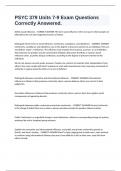Exam (elaborations)
PSYC 379 Units 7-9 Exam Questions Correctly Answered.
- Module
- Institution
PSYC 379 Units 7-9 Exam Questions Correctly Answered. Define social influence. - CORRECT ANSWER The term social influence refers to ways in which people are affected by the real and imagined pressures of others. Distinguish three forms of social influence: conformity, compliance, and obedienc...
[Show more]



